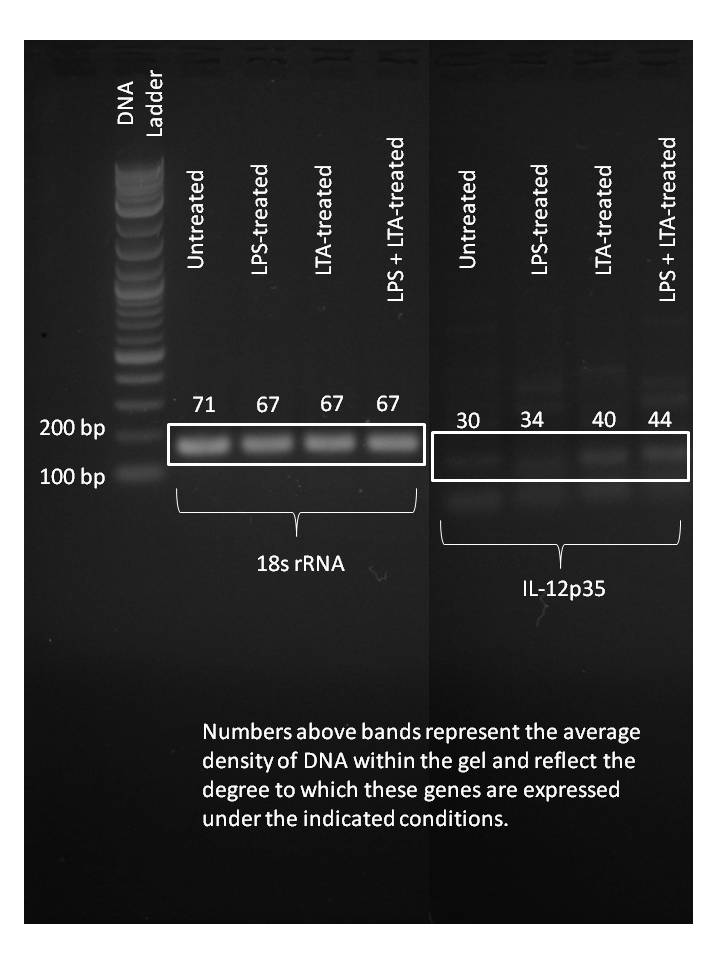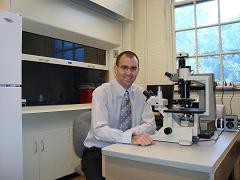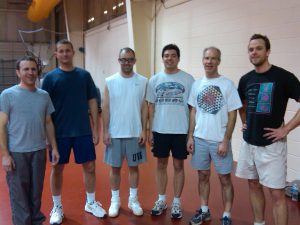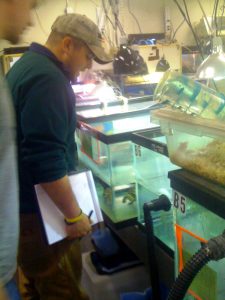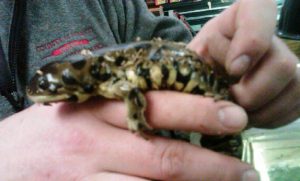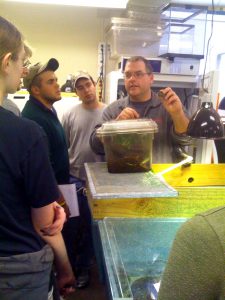Author Archives: admin
Analysis of gene expression in yeast using microarrays
This is an image of a microarray from a lab project in the spring 2010 Genomics class. Each spot represents one of the ~6200 genes that are found in the budding yeast Sacchraomyces cerevisiae. In this case, gene expression at different temperatures is being compared by isolating mRNA from cells grown at each temperature, labeling each with a different colored fluorescent marker, and exposing both to the DNA present on the microarray. While most of the genes show strong expression at 23 degrees C (green), a few show strong expression at 37 degrees C (red), the temperature in which mutations of interest in these strains are active. The class is currently working to identify these spots and understand why these particular genes may show elevated expression at elevated temperatures with these mutations.
2010 Biology Faculty Dodgeball Team
Herpetology field trip as described by the students…
[January 26, 2010] With a fearless professor at the helm, we set off for the Three Lakes Nature Center & Aquarium in Henrico, VA, to have a private session within the confined inner workings of the center. Three Lakes Nature Center displays an impressive range of not only local amphibians & reptiles in captivity, which was our main focus, but also birds and insects along with their aquarium that holds dozens of Virginian freshwater fish species. My personal preference was to take note on the local captured turtle species that spend their days roaming around their own miniature-sized ecosystems, complete with personal pond and little fish companions that double as snacks.
– Sam Smith
A guided tour [Thank you again, Wade!] showcasing over twenty species left the class mesmerized by the numerous creatures many will never see in nature… Rarely seen by humans except during the breeding season, Tiger Salamanders (Ambystoma tigrinum) spend the majority of their lifetime in borrows two feet below ground. Their bright coloration deters supposed predators; however, due to their wide range tiger salamanders only have a 50% chance of breeding more than once in the wild. With the upmost devotion, these critters will return to their birthplace no matter the distance to breed. The protection of such species is in our control, and we must protect such individuals for years to come.
– Allen Luck
Visiting the Three Lakes Nature Center gave us the chance to see some native species of reptiles and amphibians that we might not have the chance to see elsewhere. Many are found in different parts of Virginia [than Farmville], such as the Map Turtles, Mudpuppies, and Pine Snakes, found in the Western mountains of the state. Rainbow snakes and Eastern Chicken Turtles are found along the coast. Some species we saw are very rare in the wild, such as the Eastern Chicken Turtle, Diamondback Terrapin, and Pine Snake.
– Erica Rutherford
In the back rooms, we had the chance to see some of the animals that were not on display, including other specimens of the species on exhibit. Others were nonnative species from other parts of the country or world. There were a number of interesting turtles (I had never heard of a soft-shell turtle) and snakes in the main exhibit but the majority of the living specimens are kept in an area the general public doesn’t often have the chance to visit. Behind the scenes, we saw a number of rare amphibians that that we probably wouldn’t have seen in the wild here in Virginia. One such rare amphibian was an albino [marbled] salamander, an incredibly rare find; to our guide’s knowledge, it is the only known captive albino salamander of its species.
– Alex Davidovich
Personally, my favorite creature was the giant snapping turtle. With its long neck exposed and its tail reached straight out, I truly got an understanding of just how enormous and magnificent these creatures truly are. His aggressive nature was obvious and was demonstrated when someone tried to approach the glass. He was quick to go into action by turning his head and heading toward the glass with his neck extended in a very uneasy looking manner. The shear beauty of this creature is really not something that can be described.
– Zach Harrelson
With two lakes to fish, areas to feed the ducks, and shelters for picnics, Three Lakes Park is a great place to take families. Both young and old will be entertained by the endless possibilities.
-Allen Luck
Biology Grad School Session on February 4
The entire Biology Department faculty will hold a special session on the afternoon of Thursday, February 4th (at 4 pm in Gilmer 105) on the topic of graduate school.
-What is grad school like?
-How do I choose the right grad school for me?
-How do I get into grad school?
-How is grad school different from professional school?
-What do grad schools look for in prospective students?
-Should I go for a master’s degree or Ph.D?
-How do I get a research assistantship, teaching assistantship, stipend, or other way to pay for grad school?
These and many other questions will be tackled.
Please mark your calendar and make plans to attend. Spread the word to fellow students too—all are welcome.

